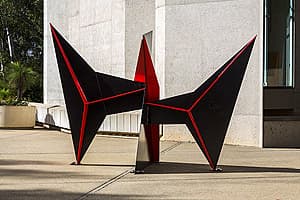

Alexander Calder
Learn moreLa Bobine [Bobbin] 1970
© Calder Foundation, New York/Copyright Agency Purchased 1972
More detail | PermalinkDuring the last two decades of his life Alexander Calder devoted much of his time to increasingly monumental outdoor sculptures. In opposition to his smaller and kinetic mobiles, works like La Bobine 1970 are known as ‘stabiles’. This term was coined by artist Jean Arp in 1932 to describe Calder’s sculptures that were made to be stationary and sit directly on the ground.[1] These works increased in size as the artist was commissioned to create them as large architectural installations in both America and Europe. Unlike more traditional public sculpture, Calder’s stabiles dominate the area they sit in, often so large that people are forced to walk under them, thereby interacting with the work rather than simply appreciating it from afar.
Eventually the sculptures became so big that it was no longer possible for the artist himself to construct them in his studio. Describing his working process in 1969, Calder noted how he perfected the visual effect in maquette form before it was enlarged to the desired size by metal-work specialists. Small tweaks were added by the artist before the final bracing was again done by the manufacturer.[2] La Bobine was fabricated by Etablissements Biémont in Tours, located near Calder’s studio at Saché, France. Many of the stabiles were shipped in flat-pack form and installed according to the artist’s numbered and colour-coded instructions. As well as being a helpful way to transport these monumental works, it also allowed them to be sent to their owners in a way that avoided customs issues.[3]
Like many of his later major works La Bobine was painted in familiar black and red, which accentuates the structure of the sculpture. The bright coloured edges pop out against the black, creating two turbine-like shapes, one on either side of the central axis. Describing his use of red in this way, Calder said: ‘It’s really just for differentiation, but I love red so much that I almost want to paint everything red. I often wish I’d been a fauve in 1905.’[4] As an American artist who worked between his home country and France for much of his career, Calder’s titles often relied on variations and anomalies in translation between French and English. La Bobine literally translates as ‘spool’ or ‘bobbin’, but may also refer to a grotesque figure.
Simeran Maxwell
[1] Jean Lipman, Calder's Universe, Viking Press, New York, 1976, p 305.
[2] As above, pp 305–6.
[3] See ‘Who is Alexander Calder?’, at http://www.tate.org.uk/art/artists/alexander-calder-848/who-is-alexander-calder, accessed 14 February 2018.
[4] Calder in Katharine Kuh, The artist’s voice: Talks with seventeen artists, Harper & Row, New York, 1962, p 41.

